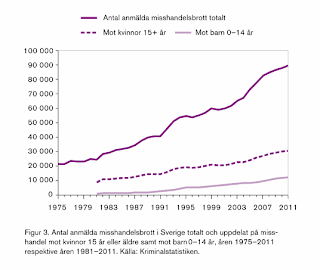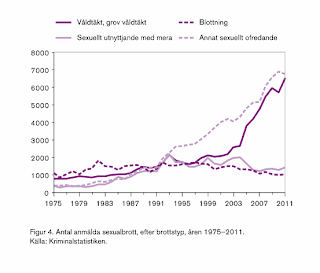Yes, I know there's Betteridge's law for these situations, but I have noticed this issue being mentioned more often in places I frequent online recently. The idea is that Sweden is becoming horribly violent with rape statistics going through the roof, often with the implication that it's because we're too soft on crime or the ever-present specter of immigration. Naturally this is also a line pushed by populists and nationalists looking for more success in the next election, and it's a line people tend to believe.
However, the answer to the title's question is no. NO.
This is not to say that there isn't a rape problem or culture, that it's not something that is often treated incredibly poorly, that there doesn't exist extensive problems with victim-shaming and rape apologia, nor that Sweden doesn't have a high rate of rape and sexual violence (something that the EUICS from 2005 suggests). However, the charge that rape and violence is clearly on the increase is simply not true. For evidence, let us go to Brottsutvecklingen i Sverige 2008-2011 (Crime Development in Sweden 2008-2011) by the government body BRÅ (The Swedish National Council for Crime Prevention).
Let's start off with two charts that people use to make the case that we're dealing with an unprecedented increase in violent crimes in Sweden (on page 73 and 115, respectively):
The thick line of the first graph shows the development of reported assault cases in Sweden since 1975 (the dotted line is assault against women age 15 and higher, and the lowest line is against children 0-14 years). The thick line of the second graph shows reported rape cases in Sweden since 1975 and the other lines other types of sexual crime. So, case closed, right? Since 1990, we've had more than a doubling of assaults and almost a quadrupling of rapes!
Well, no. These tables show crime reports to the police, which change over time due to many different factors. First and foremost, for a crime to be reported either a victim, bystander, or other person has to report it. To report it, the population has to think that the police are trustworthy, how easy it is, and that it would make sense to report it. Rape is a crime where the willingness to report has changed over time due to changes in social acceptance of rape and still depends very much on the nature of the crime. Standards have also changed as to what is an acceptable level of violence before you bring in the police (perhaps particularly when it comes to schools), and insurance companies demanding a police report can incentivize people to report crimes that they otherwise wouldn't.
Secondly, crime statistics depend on technical issues like how police register crimes, how much they are pushed to report potential crimes while patrolling, and how much repetition happens if several people report one crime (say if an assault is seen by 20 people) and whether duplicates are removed. In 1990 the Swedish police changed their reporting system and decreased the number of checks to get rid of duplicates.
Trust for police, police procedure for reporting crime, the accessibility given by the internet, and standards for what we accept in regards to violence before we go to the police are all things that change over time.
Some of this might seem a bit like hand-waving, so I'll give the best example of discrepancy between reported crime and actual crime (page 44):
The thick line here is the statistic for reports of "deadly violence". An increase from about 100 in 1990 to 250 in 2011. Also a shocking statistic, were it to reflect reality. The lower two lines, which are hovering around 100 the entire period, measure the number of people who have died from deadly violence per year according to cause-of-death statistics collected by hospitals and police. Deadly violence is one of the few cases where we can be relatively sure that there is very little underreporting; most people who are victims of it are found, and it's unlikely that attempts to hide bodies change over time. So in this case, the reported crime statistic is about 2.5 times higher than the actual number of cases in Sweden. Remember how I said that the Swedish police changed their system for reporting crime in 1990? Except for duplicates, many reported cases of deadly violence also turns out to be due to suicide and accidents, and unless they're removed from the system, obviously the total will be much higher than the real number.
Of course, deadly violence is a special case; every other crime is reported less than the actual number and by a significant amount, for several different reasons. An increase in crime reports can be a good thing if it means that more people report if they are victims to a crime, but it can also mean that the same cases that used to be reported are getting reported in duplicate and triplicate.
So what is the current state of rape and violence in Sweden? The answer seems to be "much the same as it was a decade ago". The reason I feel comfortable making that point is statistics derived from other sources. Every year government agencies send out large surveys about what has happened to people in the past year, and some questions ask about victimization. At the same time, all hospitals register the cause of patient injuries when they are treated in hospital. Both these measurements have problems, to be sure, but there is in my mind little reason to believe that there is much change over time in measurement error (in other words, while not everyone will answer a survey truthfully (and many won't answer at all) and hospitals can register causes wrong, this is not something that changes much over time - about the same amount of error will occur year-to-year, meaning that variations are more likely to reflect real-world trends). Let me begin with violence (pages 71-72):
The first graph here is the rate of people (as opposed to absolute numbers of the crime statistics above) responding with "yes" when asked if they have been targeted by any kind of violence (the thick line) or assaulted (the lower line) in the last year, the thick line representing the answers from ULF, the Swedish Living Conditions Survey, which has been going on longer than NTU, the national safety/security survey. As one asks about assault and the other any kind of violence, the levels are different where they overlap, but the message seems clear: among the respondents used in these surveys (a random sample of about 5000 and 13000 new people per year, respectively, which is a very good sample size), the rate of violence did not increase in the past decade (2006 seems to have been a violent year, however).
The second graph shows hospital records of people hurt by violence (thick line, in number of people per 500 000 of inhabitants in Sweden), knife-wounded (dotted line, in number of people per 1 million), or wounded by gunshot (lowest line, in number of people per 2 million). Though the thick line has more variation over time, it also shows little change in the level of needed care due to violence over the past decade.
As such, I see little reason to believe that assaults and other forms of non-sexual violence has increased particularly in Sweden over the last decade.
As for rape, I can't be as certain, since the NTU only asks (in one question) whether a person has been "molested, forced, or assaulted you sexually", which puts several different sexual crimes together. At any rate, here are the results (page 113):
Over the years the survey has been in use, the number of people in percent (thick line is women, middle line is the total sample, and the dotted line is men) who have answered that they have been molested, forced or assaulted has held more or less steady, possibly a small decrease. Now, it is possible that for whichever reason rape has increased significantly while other forms of sexual crimes have decreased, but I see little reason for that to happen. As we see in the chart over reported crimes at the beginning of this post, rape is a third of sexual crimes, and between 2005 and 2011 it increased threefold; for that not to show up at all here suggests to me that the reported crime increase is due to other reasons (increased likelihood of reporting, police procedure, etc), and indeed, the NTU survey has shown that people are becoming more likely to report sexual crimes to the police.
So in all, I think the amount of rape committed is still horribly high, but that it isn't getting worse. We need take a strong stand against those who would claim that Sweden is a downward spiral of rape and violence because of whichever reason the reactionaries are currently pushing (which is most often immigration), and start dealing with rape culture, make sure rape survivors are treated well by the justice system, and stop legitimizing the behaviour of rapists. Those last three should be pretty obvious. But we all know that they aren't.





